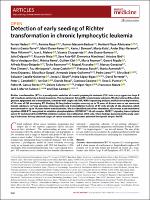
Data
2022-08Autor/a
Resum
Paraules clau
Limfoma de cèl·lules b; Epigenètica del càncer; Leucèmia limfocítica crònica
Citació recomanada
Nadeu F, Royo R, Massoni-Badosa R, Playa-Albinyana H, Garcia-Torre B, Duran-Ferrer M, et al. Detection of early seeding of Richter transformation in chronic lymphocytic leukemia. Nat Med. 2022 Aug;28:1662–71.
Audiència
Professionals
Empreu aquest identificador per citar i/o enllaçar aquest document
https://hdl.handle.net/11351/9338Aquest element apareix a les col·leccions següents
- HVH - Articles científics [2972]
- VHIO - Articles científics [865]
Els següents fitxers sobre la llicència estan associats a aquest element:

